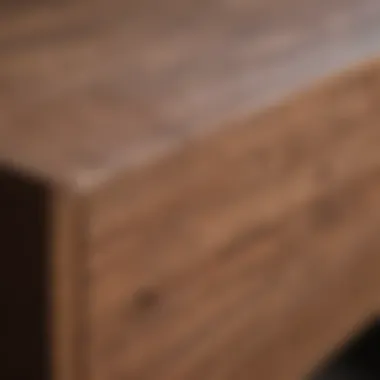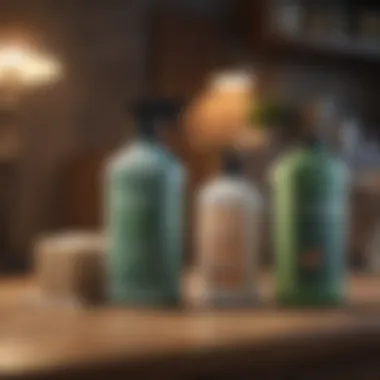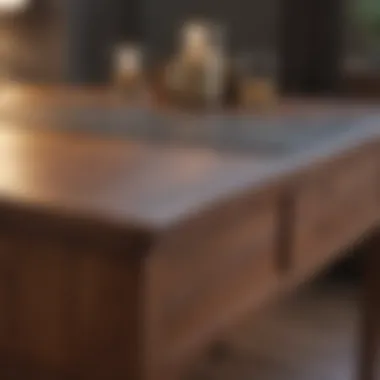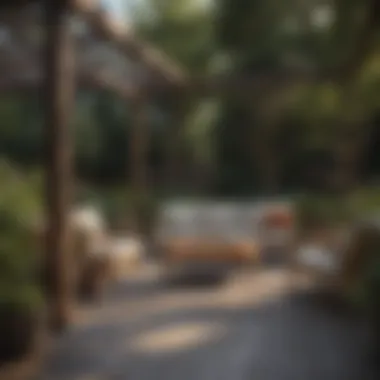Comprehensive Guide to Polywood Cleaning and Care


Intro
Polywood furniture has become a go-to choice for those who require durability coupled with aesthetic appeal. This guide will detail the essentials of cleaning and maintaining Polywood items. Understanding how to care for this unique material enhances the longevity and visual quality of outdoor and indoor furniture.
Polywood is crafted from recycled plastics, making it an eco-friendly option. It mimics the appearance of traditional wood while resisting fading, splintering, and rot. As a result, it is popular among homeowners seeking low-maintenance yet elegant solutions. Cleaning and maintaining Polywood is straightforward, but it requires specific knowledge of the material’s characteristics.
This article will highlight effective cleaning techniques, recommend the best products for Polywood care, and provide preventative measures to uphold the furniture's aesthetic value.
Design Inspiration
When selecting Polywood furniture, design aspects are as important as the practical considerations. The styles and colors available can significantly influence the overall ambiance of your space.
Current Interior Design Trends
Currently, a shift towards sustainable and minimalist design is notable. Homeowners are choosing furniture that combines style with a commitment to eco-friendly materials. Polywood fits perfectly into this trend with its sleek designs and earth-friendly origins.
Additionally, the clean lines of Polywood can adapt to various design themes, from modern to traditional. Organic shapes and simple silhouettes give spaces a contemporary touch while retaining warmth.
Color Palettes and Their Effects
Choosing the right color for your Polywood furniture can transform your space. Popular color choices include neutral shades like white, gray, and beige, which offer versatility and elegance. These colors blend seamlessly with natural surroundings, enhancing your garden or patio.
Bright colors such as turquoise or coral can energize outdoor spaces, making them feel more vibrant and inviting. Consider how color impacts mood. Lighter shades tend to evoke calmness, while bold colors provide excitement and energy.
Color choice in outdoor furniture not only reflects personal style but also influences the overall atmosphere of your space.
By understanding current design trends and color impacts, you ensure that your Polywood selections not only look good but also enhance your living experience.
Understanding Polywood
Understanding Polywood is essential for homeowners and garden enthusiasts who seek to maintain the quality and appearance of their outdoor furniture. Polywood is a material that offers substantial benefits, particularly suited for outdoor settings. Familiarity with its properties can influence the cleaning methods and maintenance strategies utilized to prolong the life of furniture made from this innovative material.
What is Polywood?
Polywood is a brand of high-density polyethylene (HDPE) that imitates the look of natural wood without the drawbacks associated with traditional lumber. Manufactured from recycled plastic, Polywood is engineered to withstand the rigors of outdoor environments while being free from the splinters, warping, and moisture-related issues commonly found in wood. This makes it a popular choice for furniture makers.
Another notable feature of Polywood is that it requires minimal maintenance compared to wood. While it has the aesthetic appeal of wood, its resistance to mold, mildew, and fading from sun exposure makes it a preferable option for outdoor use.
Benefits of Polywood
Polywood offers a multitude of benefits that appeal to homeowners:
- Durability: Polywood is designed to endure harsh weather conditions without losing its structural integrity.
- Low Maintenance: Unlike traditional wood, there is no need for painting or staining. A simple wash is usually sufficient to maintain its appearance.
- Eco-Friendly: Created from recycled materials, Polywood contributes to environmental conservation efforts.
- Variety of Styles: The product comes in many colors and styles, allowing for customization to complement any outdoor decor.
These advantages highlight why Polywood stands out as a leading material in the outdoor furniture market.
Types of Polywood Products
Polywood manufactures a wide array of products, suitable for various outdoor living needs. Some common types include:
- Adirondack Chairs: Classic and comfortable, perfect for relaxing in gardens or on patios.
- Dining Sets: Sturdy tables and chairs ideal for outdoor dining experiences.
- Benches: Great for park-like settings, offering a perfect spot for social gatherings.
- Recycling Containers: Combining functionality and environmental responsibility, these encourage recycling in parks and residential areas.
Exploring the vast range of Polywood products can aid homeowners in selecting the right pieces for their specific outdoor spaces.
Importance of Cleaning Polywood
Keeping Polywood furniture clean is crucial for maintaining its appearance and extending its lifespan. Polywood is popular not just for its aesthetic appeal but also for its resilience to various elements. However, neglecting its care can lead to accumulation of dirt, stains, and potential damage over time.
Why Regular Maintenance is Essential
Regular maintenance serves multiple purposes. First, it enhances the visual appeal of Polywood. Dust, grime, and organic matter can accumulate on the surface, detracting from its beauty. By implementing a consistent cleaning schedule, you preserve the vibrant colors and smooth textures that initially attracted you to these products. Moreover, consistent cleaning also aids in identifying any early signs of wear or damage. By spotting these issues promptly, necessary repairs can be undertaken before they escalate.


Another significant factor is the health consideration. Mildew and mold can develop under certain conditions. This is especially true for items placed in shaded areas or regions with high humidity. These growths not only damage the material but can also pose health risks for family and guests. Therefore, cleaning Polywood regularly becomes a health consideration alongside aesthetic concerns.
Impact of Environmental Factors
Environmental factors dramatically influence the maintenance ease and degradation pace of Polywood. Sun exposure is one such critical factor. Prolonged sunlight can lead to fading and discoloration of Polywood surfaces, making them appear worn out. Rain and moisture also play a role. While Polywood resists moisture better than traditional wood, water pooling and stagnant conditions may encourage mold growth.
Pollutants like bird droppings, tree sap, and dirt can accelerate surface deterioration. These contaminants can bond with the Polywood’s surface if left unchecked, resulting in stubborn stains that complicate future cleaning efforts.
In addition, seasonal changes can also affect the maintenance requirements. For instance, in autumn, falling leaves and debris can settle on furniture and require more frequent attention. Awareness of these factors guides homeowners towards a proactive maintenance approach.
"Effective cleaning and maintenance of Polywood preserve both its aesthetic and functional qualities, ensuring these outdoor assets remain attractive and useful for years to come."
In summary, understanding the importance of cleaning Polywood is fundamental in preserving its appeal and longevity. Regular maintenance not only upholds the aesthetic integrity of the furniture but also protects it from environmental impacts that might cause premature damage.
Cleaning Techniques for Polywood
Cleaning Polywood properly is essential for maintaining its appearance and longevity. This section breaks down various cleaning techniques that are effective and easy to implement. Understanding these methods can enhance the aesthetic quality of Polywood furniture while safeguarding its functionality.
Basic Cleaning Procedures
Before diving into specific products and methods, it’s important to establish basic cleaning procedures for Polywood. Regular cleaning is recommended. A simple routine can greatly extend the furniture's lifespan. Here are some key steps to follow:
- Dust Regularly: Use a soft cloth or duster to remove dust and debris from the surface of the furniture.
- Wipe with a Damp Cloth: After dusting, dampen a cloth with water to wipe down surfaces. This removes any residual dirt effectively.
- Inspect for Damage: While cleaning, take time to inspect for any signs of wear or damage. This allows for timely repairs and maintenance.
Using Soap and Water
The traditional method of cleaning Polywood involves using soap and water. This method is effective and gentle on the material. Here’s how to properly clean using this method:
- Prepare a mixture of mild dish soap and warm water. Avoid using bleach or strong detergents, as they can damage the finish.
- Using a soft sponge or cloth, dip it in the soapy water, and wring it out slightly to prevent excess water from dripping.
- Scrub the surface gently, focusing on areas that show signs of dirt or buildup.
- After scrubbing, rinse the sponge or cloth in clean water and wipe away any soap residue.
- Finally, dry the surface with a clean towel to prevent water spots.
Applying Vinegar Solutions
Vinegar solutions provide a natural cleaning alternative while being safe for Polywood. Vinegar is effective in cutting through grime and can remove stubborn stains. Follow these steps:
- Combine equal parts of white vinegar and water in a spray bottle. This solution is safe and effective for most cleaning needs.
- Spray the vinegar solution onto the affected areas and let it sit for a few minutes to break down the grime.
- Wipe with a soft cloth or sponge, applying slight pressure if necessary.
- Rinse the area with water afterward to remove any vinegar residue.
- Allow the furniture to air dry.
It's essential to avoid abrasive materials while cleaning Polywood. Scratching the surface can lead to permanent damage.
By understanding and implementing these cleaning techniques, homeowners can ensure their Polywood furniture remains in excellent condition. Regular attention to cleaning not only enhances the aesthetic appeal but also prolongs the life of these outdoor assets.
Dealing with Stains on Polywood
Addressing stains on Polywood is critical for maintaining the appearance and integrity of this material. Stains, if left untreated, can deteriorate the aesthetic appeal of furniture and reduce its longevity. Regular attention to any staining can prevent potential issues, ensuring that the furniture remains visually appealing and structurally sound.
Common Types of Stains
Stains on Polywood can originate from various sources. Some common types include:
- Food and Beverage Stains: Spills from drinks or food can create unsightly marks if not cleaned promptly.
- Grease or Oil Stains: Oil from hands or cooking can lead to dark spots that are easily noticeable.
- Dirt and Mud Stains: These often occur when furniture is used outdoors, especially during wet weather.
- Fading from Sun Exposure: Prolonged exposure to sunlight can cause discoloration, although it is not a stain in the traditional sense.
Understanding these stains helps in choosing the right cleaning methods and products for effective removal.
Effective Stain Removal Methods
Successfully removing stains involves using appropriate cleaning techniques. Two popular methods include:
Using Baking Soda
Baking soda is a natural and non-toxic cleaning agent that has various applications, one of which is stain removal. It is mildly abrasive, which allows it to scrub away dirt and stains without scratching the Polywood surface. This characteristic makes it a beneficial choice for homeowners looking for an effective yet gentle cleaning method.
The unique feature of baking soda is its ability to absorb odors as well as stains. Its simple mixture with water creates a paste that can be applied to the stained area. Advantages of this method include:
- Eco-friendly: Safe for both the environment and the user.
- Cost-effective: Common household item, often readily available at minimal cost.


A possible disadvantage is that for tough or set-in stains, baking soda may need to be combined with other cleaners for effective results.
Utilizing Commercial Cleaners
Commercial cleaners are specifically formulated for various stain types, making them a popular choice among homeowners. These cleaners are designed to dissolve and lift stains more effectively than natural alternatives.
The primary advantage of commercial cleaners is their strength and speed in removing even the toughest stains. Many products are very convenient to use and require little preparation. However, it is essential to choose a cleaner that is safe for Polywood to avoid damage.
Some disadvantages might include:
- Harsh Chemicals: Many commercial cleaners contain tough chemicals that could harm both the environment and the Polywood itself if not used correctly.
- Cost: These products can sometimes be more expensive than natural options.
Overall, knowing which method to use for stain removal is imperative in sustaining the quality of Polywood furniture.
Preventative Care for Polywood Furniture
Preventative care plays a significant role in maintaining the longevity and performance of Polywood furniture. Unlike traditional wood, Polywood is composed of high-density polyethylene, which is already resistant to various elements. However, proper preventative measures can enhance these inherent properties. The focus here is on maintaining the furniture’s appearance and integrity for years to come. By implementing preventative care, homeowners can minimize long-term damage and save time on extensive cleaning or repairs.
Choosing the Right Location
The placement of Polywood furniture is critical for its longevity. It is essential to consider sunlight exposure and moisture in the area where the furniture will be located. Direct sunlight, over time, can lead to fading colors. Thus, it may be advisable to position Polywood furniture in shaded areas. Avoid placing it underneath trees or plants that shed leaves and branches, as these can stain or damage the surface. Keep in mind that moisture accumulation can lead to mildew growth, even on a material that is resistant to most elements. Selecting a location with proper drainage will help mitigate these risks.
Key Considerations for Location Selection:
- Sun Exposure: Try to place furniture where it gets some shade to reduce color fading.
- Nearby Vegetation: Keep away from trees or shrubs that can drop debris on the furniture.
- Drainage and Airflow: Ensure there is good drainage and airflow to prevent moisture build-up.
Applying Protective Coatings
Applying protective coatings is another proactive measure to enhance the durability of Polywood furniture. While Polywood does not require traditional varnishes or paints due to its composition, certain products can provide an extra layer of defense against dust, dirt, and environmental factors. Look for ultra-violet (UV) resistant sprays designed specifically for plastics. These can help maintain the appearance and prevent any surface scratches.
Steps for Applying Protective Coating:
- Clean the furniture thoroughly using recommended methods before application. This ensures that dirt does not get trapped underneath the coating.
- Choose a UV-resistant spray that is compatible with Polywood.
- Apply in a well-ventilated area, allowing proper air circulation during application.
- Follow the manufacturer’s instructions carefully to achieve the best results.
Applying protective coatings can not only keep your Polywood furniture looking new but also save costs in future maintenance.
In summary, taking preventative care steps such as selecting the right location and applying protective coatings are integral for maintaining the quality of Polywood furniture. These strategies not only extend the life of the furniture but also ensure it remains a beautiful addition to any space.
Long-Term Maintenance Strategies
Maintaining Polywood furniture over time requires systematic approaches. Long-term maintenance ensures that the aesthetic appeal and durability of your furniture are preserved. By adopting the right strategies, homeowners can minimize wear and tear while enhancing the longevity of their Polywood assets.
One important factor in this maintenance is keeping a consistent cleaning schedule. Regular cleaning prevents debris and dirt from building up, which can cause scratches or stains. Additionally, monitoring the environment where the furniture is kept plays a crucial role. Factors such as sunlight exposure, humidity, and dirt levels can impact the condition of the furniture.
Annual Deep Cleaning
An annual deep cleaning is essential for keeping Polywood furniture in optimal condition. This process typically involves thorough washing, inspection, and the application of any protective products. Deep cleaning removes stubborn dirt, grime, and any residues that regular cleaning might miss.
To properly conduct an annual deep clean, follow these steps:
- Remove all cushions and accessories from the furniture.
- Use a soft brush to sweep away loose dirt, leaves, and debris.
- Prepare a cleaning solution with mild soap and warm water.
- Soak a cloth in the solution and wipe down all surfaces thoroughly.
- For tough areas, a non-abrasive scrub pad may be used cautiously.
- Rinse with clean water to remove any remaining soap residue, then let the furniture dry completely.
- Inspect all seams and joints for any signs of wear or damage.
This process not only cleans the furniture but also prepares it for any maintenance needs that arise. Regular deep cleaning will maintain the original color and finish of Polywood, keeping it looking new for years.
Inspecting for Damage
Inspecting for damage is a critical component of long-term maintenance. Regularly checking the furniture can help homeowners catch any issues early, preventing more significant problems down the line.
When inspecting your Polywood furniture, consider the following aspects:
- Visual Inspection: Look for any cracks, warping, or discoloration. This can occur due to environmental exposure over time.
- Structural Checks: Ensure that all joints, screws, and fasteners are secure. Loose components can lead to further damage.
- Surface Condition: Examine the surface for scratches or stains from heavy usage.
It is advisable to conduct these inspections at least twice a year or more frequently if the furniture endures heavy use.


By integrating these long-term maintenance strategies into your routine, you will ensure that your Polywood furniture remains functional and attractive over the years. The benefits are twofold: practical maintenance and the sense of satisfaction that comes with caring for your outdoor spaces.
"Maintenance is not just about cleaning; it is a way to protect your investments and prolong their life for many seasons to come."
Choosing Cleaning Products for Polywood
Selecting the right cleaning products for Polywood furniture is crucial for maintaining its integrity and appearance. Polywood is made from high-density polyethylene, a material that mimics the look of wood but is far more resistant to moisture and fading. However, not all cleaning agents are suitable for it. Using improper products can lead to deterioration or damage over time. Thus, understanding the various options available and their respective benefits is essential for extending the lifespan of your Polywood.
A carefully chosen cleaner not only removes dirt and stains but also protects the surface. Products with natural ingredients are often preferable, as they are effective yet gentle. Ensuring that these cleaners are safe for the environment is another consideration. Eco-friendly products help preserve the surroundings while keeping your furniture looking pristine. Additionally, selecting cleaners specifically designed for outdoor furniture can guarantee optimal results.
"Using the right cleaning products is not just about cleanliness; it's about preserving the aesthetics and durability of your furniture."
Recommended Eco-Friendly Cleaners
When searching for eco-friendly cleaners, several brands stand out. Look for products that contain biodegradable ingredients, ensuring that they will not harm the environment. Brands like
- Simple Green
- Seventh Generation
- Dr. Bronner's
These offer effective solutions without the harshness of synthetic chemicals. Furthermore, readers may consider creating their own cleaning solutions using simple ingredients. A mixture of vinegar and water can effectively clean surfaces without harmful residues. Another option is using a baking soda paste to target specific stains.
Using these eco-friendly cleaners means you can maintain your Polywood without sacrificing environmental principles. Always check for the ingredients list to ensure safety for both the furniture and the ecosystems surrounding your home.
Avoiding Harsh Chemicals
It is important to avoid harsh chemicals when cleaning Polywood. Agents containing bleach or ammonia can have detrimental effects on the surface. They might strip away any protective finishes, leading to accelerated wear and tear. In high concentrations, these chemicals can cause discoloration and weaken the material itself.
Instead, opt for milder solutions. Even if a product claims to be effective, questioning its chemical composition is essential. Always perform a patch test in a non-visible area to assess how a cleaner interacts with the Polywood. This precaution can save you from future damage and costly repairs.
Taking time to read labels and understand the product's effectiveness against stains will pay off significantly in the long run. Maintaining Polywood does not need to involve dangerous substances; it simply requires thoughtful consideration and informed choices.
Storage Tips for Polywood Furniture
Storing Polywood furniture correctly is crucial for maintaining its integrity and appearance. Unlike traditional wood, Polywood is designed to withstand various weather conditions, but improper storage can still lead to wear and tear. Understanding how to store these items properly will prolong their life and preserve their aesthetic charm.
Preparing for Seasonal Changes
As the seasons shift, the needs of your Polywood furniture also change. Protecting it against the elements is vital. Here are key considerations:
- Assess the Weather: Before adverse weather conditions, such as snow or heavy rain, ensure you have a clear plan for storage.
- Clean Before Storing: Always clean your furniture before putting it away for the season. This helps prevent mildew or stains from setting in.
- Use Storage Space Wisely: Identify a dry, sheltered area for storage. A garage or shed is ideal. Ensure it’s ventilated to avoid moisture accumulation.
Proper Covering Techniques
If you choose not to store your Polywood furniture away completely, utilizing covers can provide effective protection. Here are some proper covering techniques:
- Choose Quality Covers: Invest in durable, water-resistant covers specifically designed for outdoor furniture. Nylon or polyester options with UV protection are beneficial.
- Ensure a Secure Fit: Make sure the cover fits snugly over your furniture. A loose cover can fly off during storms, providing no protection at all.
- Ventilation is Key: Select covers that have ventilation features. This prevents moisture buildup underneath the cover, which can lead to mold growth.
"Proper care in both usage and storage extends the lifespan of your Polywood items, keeping them looking new for many years."
By attending to these details during seasonal changes and utilizing effective covering techniques, the maintenance of your Polywood furniture becomes much more manageable. With thoughtful storage practices, the beauty and functionality of your outdoor pieces can be preserved effectively.
Culmination
In the realm of outdoor furnishings, Polywood stands out for its durability and low-maintenance needs. This article highlights the importance of cleaning Polywood correctly to sustain its integrity and aesthetic appeal. Regular upkeep not only enhances the visual aspects of the furniture but also prolongs its lifespan.
Cleaning Polywood involves a few straightforward steps. The key points established throughout the guide are vital for homeowners and enthusiasts alike. These touch upon various cleaning techniques including basic washing, stain removal methods, and protective care strategies. Understanding these methods empowers owners to tackle any cleaning challenge effectively.
Summarizing Key Points on Polywood Cleaning
To reiterate, the vital points discussed include:
- Understanding Polywood Composition: Knowledge of what Polywood is made of helps in selecting suitable cleaning techniques.
- Essential Cleaning Practices: Using simple soap and water or vinegar solutions can remove dirt and grime.
- Dealing with Stains: Familiarity with common stains and effective removal methods, like using baking soda or specific commercial cleaners, ensures that unsightly marks do not diminish Polywood's appeal.
- Preventative Measures: Choosing appropriate locations and applying protective coatings are pivotal for long-term care.
- Storage Solutions: Seasonal changes necessitate correct covering and preparation techniques for Polywood furniture.
Emphasizing the Importance of Regular Maintenance
Regular maintenance of Polywood furniture is essential. It not only preserves the brand's signature look but also protects against environmental factors. Moisture, sunlight, and dirt can cause deterioration over time. By adhering to established cleaning regimens and proactive care techniques, homeowners can reduce the chances of damage. The goal is a beautiful outdoor space free of the hassle of neglected maintenance.
Additionally, the cost-effectiveness of keeping Polywood furniture in good condition cannot be overstated. A well-maintained item means fewer replacements, translating to savings and less environmental impact in the long run. Homeowners who invest time in care will reap long-term rewards, enhancing both their property value and enjoyment.
In summary, diligent attention to Polywood care translates to elegance and sustainability in outdoor living spaces.















